Innovations in design and scalable manufacturing have led to the development of linear variable filters that cover a broader wavelength range than ever before.
TREY TURNER, ERIC BALTZ and ROGER KIRSCHNER, RESEARCH ELECTRO-OPTICS INC.
Spectroscopic optical applications have conventionally utilized dispersive elements such as diffraction gratings and, less commonly, prisms to separate light into its constituent wavelengths for spectral interrogation. Gratings have the advantage in that a wide range of dispersion levels is made available by adjusting the grating pitch, and they can be used in ways that are light-efficient. However, as they disperse the light as a function of angle, they intrinsically require a fairly complex geometry and a relatively large footprint to allow the dispersion of light across a detector. For applications where light intensity is not of concern but compactness, ruggedness and low cost are desired, linear variable filters have become an attractive alternative.
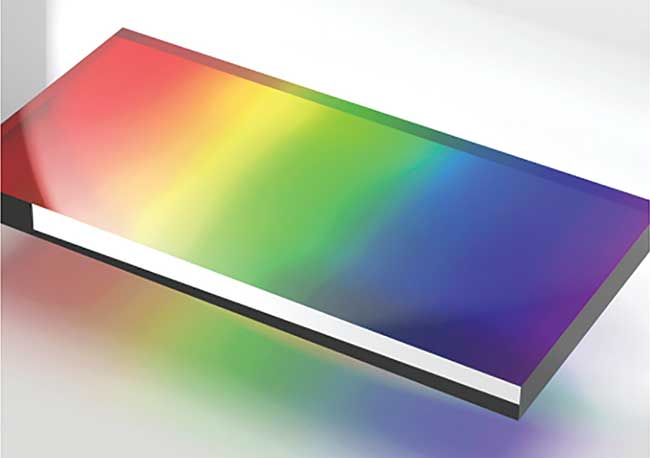
Example of a linear bandpass filter. Courtesy of Research Electro-Optics.
Linear variable filters have optical properties that change spectrally as a function of position on the physical surface of the filter. In principle, virtually any spectral characteristic can be designed in a way that allows it to vary smoothly across the surface. In practice, the most common and useful devices are bandpass filters, longpass filters and shortpass filters. The manufacturing process involves varying the filter’s many thin-film layer thicknesses along the length of the filter’s surface. As the layer thicknesses increase, the filter’s spectral characteristics shift to longer wavelengths.
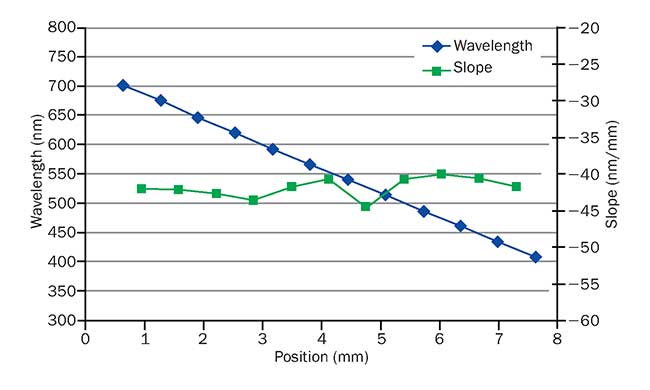
Typical linear variable filter center wavelength and slope vs. filter position. Courtesy of Research Electro-Optics.
Limited by wide blocking range
Variable filters have been available in one form or another for many years, including radially variable filters, such as gradient reflectivity mirrors for shaping laser output, and radially variable neutral density filters for shaping the radial intensity profile of a beam. Linear and annularly variable neutral density filters have been commonly used as straight forward adjustable attenuators. Until recently, however, linear variable filters have been limited in their application because the underlying deposition technology did not allow for the production of complex filter characteristics such as very wide and deep blocking ranges. They have also been fairly expensive to manufacture, since the manufacturing technology has not been highly scalable.
Conventionally, variable filters have been produced by tilting the substrate at an angle during deposition. This process has two limitations. First, as each filter must be individually tilted but otherwise located in the same plane, it does not allow for filters to be replicated across a substrate. Second, there is a maximum filter slope that can be achieved, which is fundamentally limited by the geometry of the deposition process.
Thin-film application using ion beam sputtering can be controlled using proprietary plume-shaping technology, which has solved these limitations and made possible filters that provide exceptionally wideband operation in a footprint as small as 1 × 3 mm — creating the potential to produce such filters directly on detector substrate wafers for high-volume applications. Users also benefit from the other well-known advantages of ion beam sputtering, such as low scatter and exceptional environmental stability.
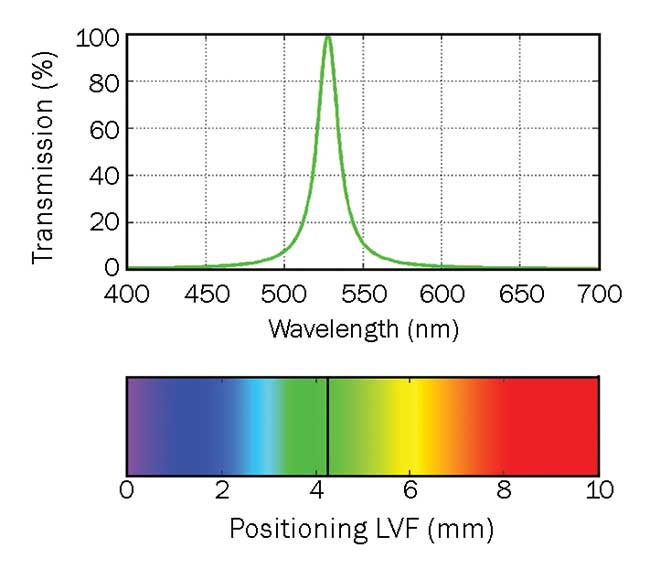
Spectral scan and relative scale available for linear variable bandpass filters. Courtesy of Research Electro-Optics.
Design trade-offs
When specifying a linear variable filter, it is important to consider certain design trade-offs. The key parameters used to specify linear variable bandpass filters are slope, wavelength range (or filter length), blocking optical density, pass band width (usually specified as full width half maximum, or FWHM) and transmission level. There will typically also be tolerances on the slope, linearity and FWHM. The FWHM will be a constant fraction of the center wavelength, meaning that the absolute width, as expressed in nm, will vary across the filter. For example, a visible range (400 to 700 nm) filter specified with a FWHM of 1.5 percent will be 6-nm wide at the 400-nm end and 10.5-nm wide at the 700-nm end.
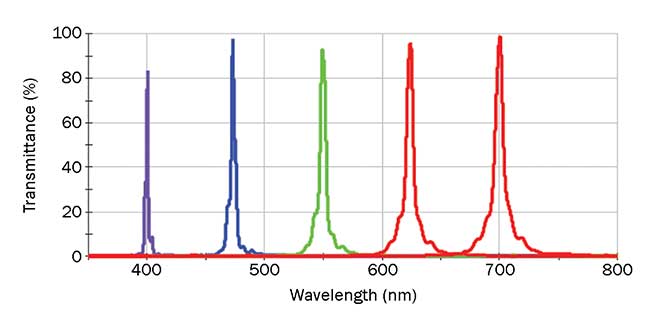
Linear variable filter design spectra vs. wavelength indicating change of bandwidth. Courtesy of Research Electro-Optics.
Transmission bandwidths of <1 percent and linearity requirements of ±1 percent are feasible over a 400- to 700-nm band. The bandwidth specification should take into account the pixel size, as it is desirable to overfill the pixels to achieve the highest spectral resolution (which can, for some applications, be higher than the resolution derived solely from the pixel density). For a broadband source, the amount of light transmitting through the filter will also depend on the FWHM, so care should be taken to ensure that it is not specified as too narrow to achieve the desired signal level.
Linear variable bandpass filters can be designed to address various regions of spectral interest from the UV to the mid-IR. The chart on the opposite page provides a few example bands and linear variable filter performance parameters.
The practical limit on the range of a linear variable filter is determined by a number of factors including the required blocking depth and the wavelength band (UV, VIS or IR). In general, deeper blocking will require more layers to achieve, so given a fixed total film thickness, there is a basic trade-off between the wavelength range and the blocking depth. Filters designed for longer wavelengths (IR) will use materials with higher refractive indices and higher index contrast so that deeper blocking can be achieved with fewer layers, but the layers are thicker (roughly constant fraction of the wavelength). In practice, the maximum achievable range will be 0.45 to 0.55 times the center of the range. For example, a filter centered at 550 nm can have a total range of about 300 nm.
High-volume measurements in minispectrometers
Linear variable filters have been incorporated into compact wavelength monitors and used in spectroscopy, gas analysis, environmental sensors, lidar and biomedical instrumentation.
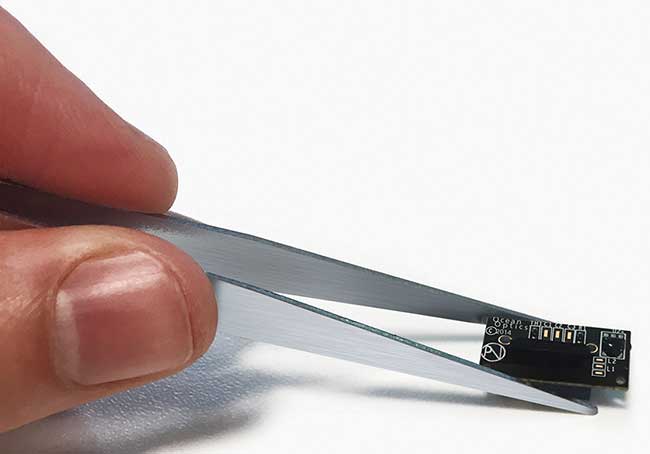
Examples of a minispectrometer and components. Courtesy of Ocean Optics.
One of the widest applications for the linear variable filter is in minispectrometers. A standard spectrometer has the basic components of a grating, either transmissive or reflective, and a sensor, usually a linear CCD or CMOS array. The resolution of this configuration is usually very good for most applications; however, the use of a grating requires space to enable the spectrum to separate. It also has the disadvantage of being affected environmentally by temperature changes due to mechanical movement. Alternatively, a three-color red/green/blue (RGB) filter combined with diode detectors can be small and inexpensive, but lacks the necessary resolution for many applications.
A minispectrometer with a linear variable bandpass filter mounted directly onto a linear CCD or CMOS sensor provides a compact, higher resolution device with inherent environmental stability. Several factors limiting standard spectrometers, especially physical size, are addressed with this approach. A linear variable filter/linear detector combination enables high-volume measurement in handheld or smaller sensors. Applications for these small higher-resolution sensors include absorbance, emission and fluorescence. Unlike 3-element RGB diode sensors, the entire spectrum of interest is measured with higher resolution.
Research Electro-Optics (REO) Inc.’s fabrication technology enables the manufacture of extremely small filters that can be below 1-mm physical dimension and allows the fabrication of linear variable filters as small as 1 × 3 mm on wafer-sized substrates.
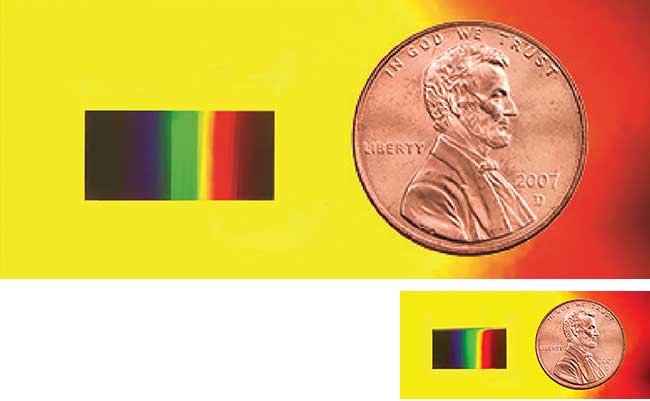
Courtesy of Research Electro-Optics.
Hyperspectral imaging and wavelength sensors
Linear variable filters can be applied to 2D detectors to produce a compact hyperspectral instrument for the UV to near-IR spectral range. The resultant advantages for these systems compared to classical grating-based systems are a very large aperture, excellent transmission, fast measurements, stray light suppression and very good signal-to-noise ratio, which enables short measurement times.
The combination of these very small linear variable filters and position sensors enable new, very accurate and low-cost wavelength sensors. Peter Kiesel, principal scientist at Palo Alto Research Center Inc. (PARC), a Xerox company, has invented a technology that can measure wavelength variations with sub-picometer resolution. It combines photodetector position sensors with a linear variable bandpass filter that converts spectral wavelength into an intensity distribution on the position sensor. A centroid calculation of the intensity distribution provides the very accurate wavelength information.
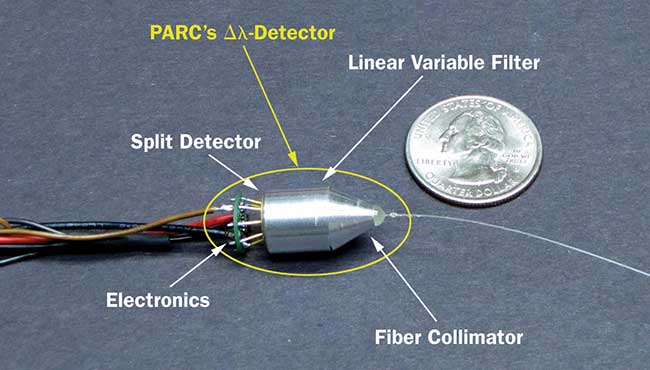
Micro-wavelength sensor. Courtesy of Xerox PARC.
This advance has applications in remote sensing, fiber sensors, crystal sensors, laser cavity and compact spectroscopy sensors, and wavelength monitors. The initial development of this technology focused on interrogating wavelength-encoded optical fiber sensors such as fiber Bragg grating sensors. The initial prototype (see sensor image opposite page) demonstrated the ability of this technology to resolve optical wavelength shifts as small as 10 fm at 10 Hz in the C-band, which is substantially better than the state of the art. More recently PARC has demonstrated that this same concept can be used to monitor extremely small (sub-picometer) wavelength changes of the centroid of broad band light sources. This would be applicable in the monitoring of LEDs or SLEDs (superluminescent diodes) or the readout of colorimetric sensors.
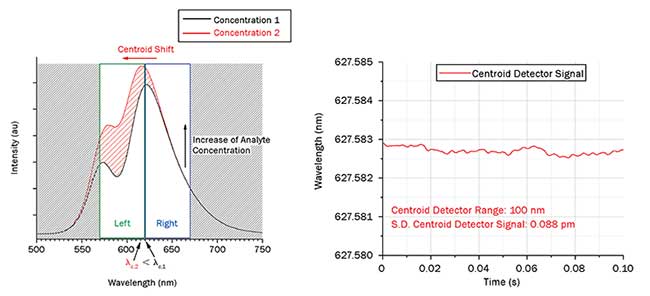
Xerox PARC’s sub-picometer (pm) measurement of broad light sources. Courtesy of Xerox PARC.
Advantages for space-based applications
The physical size and environmental advantages of using linear variable filters have significant application for instruments used for space and planetary instruments. Some of these include looking for organics, water-altered materials and minerology, and for doing Raman or laser-induced breakdown spectroscopy.
Advanced manufacturing technology has created the potential for new applications for linear variable filters. REO’s scalable manufacturing method enables submillimeter-sized filters, which can be cost-effective for new areas of application including minispectrometers, remote sensing, compact wavelength and laser monitors, fiber sensor interrogation, and more.
Meet the authors
Trey Turner is the chief technology officer with core expertise in IBS coatings at Research Electro-Optics Inc. (REO), an optics, laser component and assembly company in Boulder, Colo.; email:[email protected]. Eric Baltz is a senior R&D engineer at REO, with expertise in thin-film design, layer thickness control and LVF manufacture; email: [email protected]. Roger Kirschner is the business development manager at REO, with expertise in optical engineering and assembly; email: [email protected].
A video of a scan of a representative linear variable bandpass filter design illustrating the change in the transmission spectrum as a function of position along the filter’s 10-mm length is available on the web version of this story.